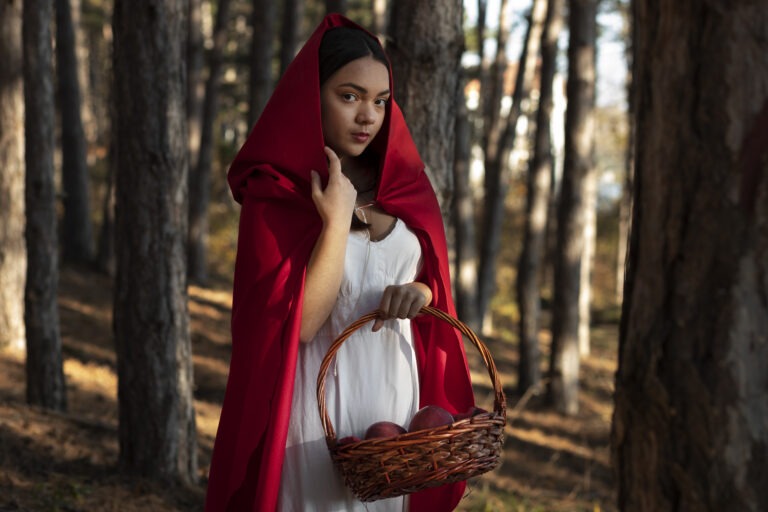Little Red Riding Hood Short Story. Once upon a time, there was a young girl named Little Red Cap. This beloved fairy tale has captivated audiences for generations with its intriguing narrative and timeless themes. In this article, we will explore the short story of Little Red Cap, analyze its symbolism and moral lessons, and discuss its impact on popular culture. IF YOU WANT TO READ THE FULL STORY, READ IT HERE!
Little Red Riding Hood Summary
Short Summary of Little Red Riding Hood
Summary of Little Red Riding Hood fairy tale. “Little Red Riding Hood” is a classic fairy tale with several variations, but a common version involves a young girl who wears a red hooded cape. The story typically unfolds as follows:
Little Red Cap is sent by her mother to visit her grandmother and bring her a basket of goodies. Along the way, she encounters a wolf who cunningly learns about her destination. The wolf races ahead to the grandmother’s house, where it often devours the elderly woman and assumes her identity by lying in wait.
When Little Red Riding Hood arrives, the wolf, disguised as her grandmother, deceives her with questions about her appearance. In some versions, the wolf eats Little Red Riding Hood as well. In other renditions, a passing huntsman or woodcutter comes to the rescue, hearing the wolf’s deceit or recognizing the danger.
The tale concludes with the rescuer saving Little Red Cap and her grandmother, sometimes by cutting open the wolf’s belly. The story serves as a cautionary tale, warning children about the dangers of talking to strangers and the importance of obedience.
Themes in the story often include the contrast between innocence and cunning, the peril of disobedience, and the notion of predators in the guise of seemingly harmless figures. “Little Red Riding Hood” has endured as a popular and enduring folk tale with variations across cultures.
The Story of Little Red Riding Hood
Little Red Riding Hood Characters
In the enchanting tale of Little Red Cap, several captivating characters bring the story to life. Each character plays a pivotal role in shaping the narrative and conveying profound themes. Let’s delve into the personalities that make this fairy tale so mesmerizing.
1. Little Red Riding Hood: The Innocent Heroine Little Red Cap, a charming and innocent young girl, is the heart of the story. Adorned in her iconic red hood, she embarks on a journey through the treacherous woods to visit her ailing grandmother. Her unwavering determination and trust in others make her a relatable and endearing protagonist.
2. The Grandmother: A Beacon of Love Nestled deep within the woods resides Little Red Riding Hood’s grandmother. This wise and caring figure provides a sense of warmth and comfort. Though frail and vulnerable, her love for her granddaughter is unwavering. Her character symbolizes the enduring bond between generations and the importance of family.
3. The Big Bad Wolf: Cunning and Mysterious Enter the notorious Big Bad Wolf, a cunning and mysterious antagonist. Cloaked in deceit, this wily creature preys upon Little Red Riding Hood’s innocence. With a hunger for both the girl and her grandmother, the wolf embodies the dangers that lurk in the shadows. His character represents the forces of deception and serves as a cautionary figure.
4. The Woodcutter: The Heroic Savior Amidst the looming threat, the woodcutter emerges as the valiant hero of the story. Armed with strength and courage, he becomes the guardian angel of Little Red Cap and her grandmother. With his timely intervention, he showcases the triumph of good over evil and restores peace and safety to the tale.
Each character in Little Red Cap carries a symbolic weight, portraying essential facets of human nature and the challenges we face. Their interactions and choices guide the narrative, unraveling the timeless themes of trust, deception, and the delicate balance between innocence and danger.
By intricately weaving these characters together, Little Red Cap weaves a tapestry of emotions and life lessons that resonate with readers of all ages.
Little Red Riding Hood Setting
Little Red Riding Hood takes place in a quaint village located near a dense forest. The vivid imagery of the woods creates an eerie atmosphere, amplifying the sense of danger that awaits our young heroine. In this idyllic village, life goes on at a leisurely pace, with its charming cottages and friendly villagers going about their daily routines. The hustle and bustle is in stark contrast to the stillness of the forest, where ancient trees loom overhead, their branches seemingly reaching out to grab anyone who dares to trespass. As Little Red Cap ventures deeper into the woods, the shadows lengthen and the sunlight that once filtered through the canopy becomes scarce. The hoot of an owl and the rustle of leaves under her feet are the only sounds that break the silence. The winding path seems to twist and turn, leading her further into the heart of the unknown. With each step, the tension builds, and her heart races in anticipation of what may lie ahead. The scent of damp earth and decaying leaves fills the air, mingling with the scent of pine and wildflowers that surrounds her. It’s as if the forest itself is alive, pulsing with an energy that she can’t quite comprehend. Every now and then, she catches a glimpse of something darting between the trees – a shadowy figure or a pair of glowing eyes, always just out of reach. The sensation of being watched, of being preyed upon, intensifies with each passing moment. Yet, in the face of all this unease, Little Red Riding Hood remains resolute. She knows she must persevere, for in that dark and mysterious forest lies the key to her grandmother’s salvation. And so, she pushes forward, her determination unwavering, her footsteps echoing through the eerie silence. The danger is palpable, but so is her courage. And as she walks, she can’t help but wonder what awaits her at the end of this treacherous journey.
Little Red Riding Hood Plot
The story begins with Little Red Riding Hood’s mother asking her to visit her grandmother, who is sick. Little Red Riding Hood sets off on her journey through the woods. Along the way, she encounters the Big Bad Wolf, who tricks her into revealing her destination. The wolf then rushes ahead, gobbles up the grandmother, and disguises himself as her.
When Little Red Cap arrives at her grandmother’s house, she is unaware of the wolf’s deception. The wolf devours her as well. However, the woodcutter, who heard the wolf’s plan, arrives just in time to rescue both Little Red Riding Hood and her grandmother. They all live happily ever after, having learned a valuable lesson about trusting strangers.
Analysis and Interpretation
Symbolism and Themes of Little Red Riding Hood
Little Red Riding Hood is an enchanting tale that is teeming with rich symbolism and thought-provoking themes. The vibrantly scarlet hood, tenderly embraced by our protagonist, serves as a palpable symbol of innocence and vulnerability, audaciously asserting the vulnerability lurking beneath the façade of youth. In stark contrast, the formidable presence of the wolf embodies danger and deceit, cunningly lurking amidst the shadows, providing a cautionary presence within the narrative. The magnificence of the forest, shrouded in an enigmatic aura, effortlessly functions as a metaphorical backdrop for the girl’s transformative journey into the intricacies of adulthood, effectively capturing the essence of the unknown in a captivating manner. Within this timeless fable, an alluring interplay of these symbolisms and themes unravels, enchanting readers of all ages with its deeply resonant messages.
The tale also delves into themes of caution, obedience, the consequences of disobedience, and the importance of trust. It warns against the dangers of straying from the designated path, emphasizing the need to be vigilant and cautious. Additionally, it highlights the significance of verifying the intentions of strangers before placing trust in them, as this can lead to unforeseen consequences. Overall, the story serves as a powerful reminder to prioritize caution, obedience, and trustworthiness in our lives.
What is the Moral of Little Red Riding Hood?
Moral of the Story Little Red Riding Hood, one of the most beloved fairy tales, imparts valuable and timeless moral lessons to its readers. Through its captivating narrative, this classic story emphasizes the utmost importance of attentive listening to parents’ wise instructions, dutifully obeying established rules, and being cautious when engaging with unfamiliar Little Red Riding Hood is a timeless tale that imparts valuable moral lessons to its young readers. It beautifully emphasizes the fundamental importance of attentively listening to parents’ instructions, dutifully obeying rules, and exercising great caution when engaging with individuals who are unfamiliar. The story offers children invaluable lessons about the potential risks they may encounter in the vast world, ultimately encouraging them to maintain a vigilant mindset at all times. By internalizing these profound teachings, children develop a heightened sense of awareness and learn to navigate life’s challenges with wisdom and discernment.
The Impact of Little Red Cap
Popularity and Adaptations
Little Red Cap has gained immense popularity worldwide. Its captivating storyline and relatable characters have made it a favorite among children and adults alike. The tale has been adapted into numerous books, plays, movies, and even video games. Each adaptation adds its unique spin while preserving the essence of the original story. Let’s delve into some notable adaptations that have breathed new life into the beloved story.
1. Literary Delights: “Red Hood” by Elana K. Arnold “Red Hood” by Elana K. Arnold is a contemporary young adult novel that puts a modern spin on the timeless tale. Set in the Pacific Northwest, the story follows a fierce and independent protagonist who confronts issues of gender, power, and agency. This literary adaptation captures the essence of Little Red Riding Hood while exploring relevant themes for today’s readers.
2. Cinematic Wonders: “The Company of Wolves” “The Company of Wolves,” directed by Neil Jordan, is a visually stunning film adaptation that weaves together elements of Little Red Riding Hood and other fairy tales. Released in 1984, this dark fantasy explores themes of sexuality, identity, and the power of storytelling. With its striking imagery and mesmerizing performances, the film offers a unique and thought-provoking interpretation of the classic tale.
3. Theatrical Marvels: “Into the Woods” “Into the Woods,” a Tony Award-winning musical by Stephen Sondheim and James Lapine, cleverly intertwines several fairy tales, including Little Red Riding Hood. This enchanting stage adaptation delves into the consequences of wishes and the complexities of human desires. With its intricate storytelling and memorable songs, “Into the Woods” has become a beloved theatrical experience worldwide.
4. Interactive Adventures: “The Path” “The Path” is an atmospheric and introspective video game adaptation of Little Red Riding Hood, developed by Tale of Tales. In this immersive and artistic game, players navigate a hauntingly beautiful forest as various incarnations of Little Red Riding Hood. The game explores themes of self-discovery, personal growth, and the consequences of choices, offering a unique and interactive adaptation for gamers.
These examples represent just a fraction of the vast array of adaptations that have reimagined Little Red Riding Hood. Each adaptation brings its own creative twist, breathing new life into the beloved story and resonating with audiences in different ways.
Through these adaptations, Little Red Riding Hood’s legacy lives on, ensuring that the story remains a cherished part of our cultural tapestry. As new adaptations continue to emerge, audiences are continually reminded of the timeless themes and enduring magic that make Little Red Riding Hood a beloved and ever-relevant tale.
Cultural Significance
Little Red Riding Hood holds cultural significance in various societies. It serves as a cautionary tale, reminding individuals to be wary of strangers and the dangers that lurk in the world. The story’s timeless appeal has helped it transcend cultural boundaries and endure through generations.
Conclusion
Conclusion of Little Red Riding Hood is that the short story continues to captivate readers with its enchanting narrative and enduring themes. This timeless tale teaches valuable life lessons about caution, obedience, and the consequences of straying from the path. Its impact on popular culture and its cultural significance further highlight the tale’s enduring legacy.
FAQs
1. Is Little Red Cap a real story?
No, Little Red Riding Hood is a fictional fairy tale that has been passed down through generations.
2. What is the moral of Little Red Riding Hood?
The moral of Little Red Riding Hood revolves around the importance of caution, obedience, and being wary of strangers.
3. Why does Little Red Riding Hood wear a red hood?
The red hood symbolizes innocence and vulnerability, highlighting the protagonist’s youthful nature.
4. Are there different versions of Little Red Cap?
Yes, there are numerous versions of Little Red Riding Hood with variations in plot details and endings.
5. What lessons can children learn from Little Red Riding Hood?
Children can learn the importance of following instructions, being cautious, and not trusting strangers blindly from Little Red Riding Hood.
6. Who wrote Little Red Cap?
The origins of Little Red Riding Hood can be traced back to several folktales from different cultures. However, the most well-known version of the story was written by Charles Perrault, a French author, in the late 17th century.
7. Why is Little Red Cap called “Little”?
The name “Little Red Riding Hood” signifies the young age and innocence of the main character. It highlights her vulnerability and the need for her to exercise caution and heed the lessons taught in the story.










